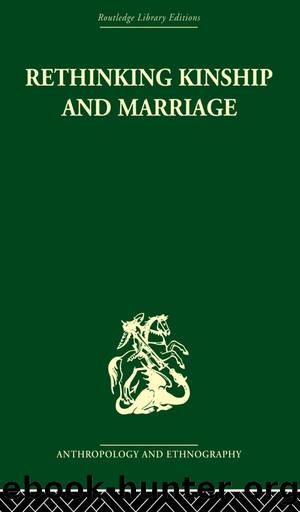Rethinking Kinship and Marriage by Rodney Needham

Author:Rodney Needham [Needham, Rodney]
Language: eng
Format: epub
ISBN: 9780415511278
Barnesnoble:
Publisher: Taylor & Francis
Published: 2011-12-13T00:00:00+00:00
TABLE 1
Developmental sequence of basic phoneme distinctions Based on Jackobson and Halle (1956: 37-42). A much fuller account of the underlying theory is given in Jakobson (1968).
Jakobson (1960) applies this theory of voice-control development to Murdock's kin-term data in the following way. He argues that, in all societies, young children will develop denotative terms for their own parents at a very early phase of their vocabulary formation. That being so, the child's initial kinship language must everywhere consist of phonemically very simple words of the type mama, papa, baba, lata, dada, nana, etc. This infant terminology has provided the historical base for the adult terms reported by Murdock.
Most anthropologists are likely to approach such arguments with a certain amount of scepticism, but the thesis is not necessarily incompatible with other styles of anthropological discourse. Notice, for example, that Jakobson's theory is essentially âextensionistâ in much the same sense as the arguments of Malinowski and Lounsbury.
One obvious criticism is that children do not invent their kin terms de novo; they learn a language from their parents and there is no reason why the parentsâ kinship language should be phonemically simple. This comment is easily evaded. If it is really the case that the small child must learn to use kin-term categories for close kin at a very early stage in its linguistic development, then it will have to be taught words which are phonemically simple. The baby-language words need not be identical to the adult words for the same categories, but they are surely very likely to be closely related to them? This fits quite well with our English experience in which the child is first taught to use a baby language containing words like mummy and daddy which are later on reformulated as mother and father. I don't think we really know whether there are close parallels for this sort of thing in the sorts of tribal languages ordinarily used by anthropologists. There is, however, good evidence that baby languages may be very similar even in quite different cultural and linguistic contexts (see Ferguson 1964). If it is the case that the adult kin terms for parents as reported in ethnographersâ listings are always reformulations of baby-language terms this would explain why the adult parental kin terms are from a statistical point of view so strikingly similar right across the map.
Perhaps you are not fully persuaded? To be quite frank neither am I. But Jakobson's thesis has got sufficient prima facie weight behind it to imply that we should look further. If the phonemic shape of father and mother terms is indirectly in-fluenced by the phonemic limitations of small children what about the words for other close kin such as brother and sister, grandparents, mother's brother, father's sisterl What about personal and possessive pronouns? It is fairly obvious that any attempt at a statistically quantifiable analysis of this extended problem would be enormously complex and laborious. In fact, I make no claim at all that any of the arguments which
Download
This site does not store any files on its server. We only index and link to content provided by other sites. Please contact the content providers to delete copyright contents if any and email us, we'll remove relevant links or contents immediately.
The Leavers by Lisa Ko(6495)
Born to Run: by Christopher McDougall(6287)
iGen by Jean M. Twenge(4708)
Sapiens by Yuval Noah Harari(4560)
The Kite Runner by Khaled Hosseini(4484)
Spare by Prince Harry The Duke of Sussex(4228)
Bullshit Jobs by David Graeber(3193)
Livewired by David Eagleman(3140)
Goodbye Paradise(2985)
Never by Ken Follett(2915)
A Dictionary of Sociology by Unknown(2523)
Harry Potter 4 - Harry Potter and The Goblet of Fire by J.K.Rowling(2423)
The Club by A.L. Brooks(2381)
People of the Earth: An Introduction to World Prehistory by Dr. Brian Fagan & Nadia Durrani(2354)
Machine Learning at Scale with H2O by Gregory Keys | David Whiting(2324)
The Social Psychology of Inequality by Unknown(2320)
Harry Potter and the Order of the Phoenix (5) by J.K. Rowling(2243)
Harry Potter and the Deathly Hallows (7) by J.K. Rowling(2237)
0041152001443424520 .pdf by Unknown(2230)
